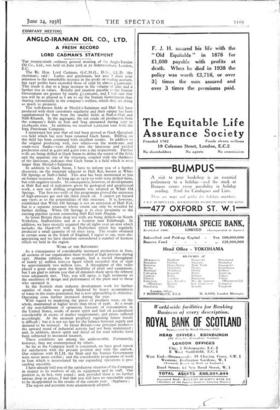COMPANY MEETING
ANGLO-IRANIAN OIL CO., LTD.
A FRESH RECORD LORD CADMAN'S STATEMENT
THE- twenty-ninth ordinary general meeting of the Anglo-Iranian Oil Co., Ltd., was held on June 20th at 20 Aldermanbury, London,. E.C.
The Rt. Hon. Lord Cadman, G.C.M.G., D.Sc., LL.D. (the chairman), said : Ladies and gentlemen, last year I drew your attention to the remarkable increase in the profit on trading account, . tut 1937 profits have exceeded those of 1936 by almost L3,000,000. This result is due to a large increase in the volume of sales and a further rise in values. Royalty and taxation payable to the Iranian Government are greater by nearly £1,000,000, and I feel sure that you will be as pleased as I am to see the Iranian Government thus sharing substantially in the company's welfare, which they are doing so much to promote.
The well-known fields at Masjid-i-Sulaiman and Haft Kel have
produced with their customary regularity and their output has been supplemented by that from the smaller fields at Naft-i-Shah and Naft-Khaneh. In the aggregate, the net crude oil production from the company's fields in Iran and Iraq amounted during 1937 to 10,289,000 tons. In addition, we received 1,220,000 tons from the Iraq Petroleum Company.
I mentioned last year that oil had been proved at Gach Qaraghuli —a field which has now been renamed Gach Saran. Drilling on this field has been continued with excellent results. In addition to the original producing well, two others—on the north-east and south-west flanks—were drilled into the limestone and yielded production rated at 4,500 and 4,000 tons a day respectively. Further wells are being drilled at Gach Saran to define the extent of the field; and the apparent size of the structure, coupled with the thickness of the limestone, indicates that Gach Saran is a field which is even larger than Masjid-i-Sulaiman.
In addition to Gach Saran, I have to inform you of a further discovery, on the structure adjacent to Haft Kel, known as White Oil Springs or Naft-i-Safid. This area has been mentioned to you on former occasions. As long ago as 1913-19 wells were drilled there, but with negative results. In consequence, however, of developments at Haft Kel and of indications given by geological and geophysical work, a new test drilling programme was adopted at White Oil Springs. The first two wells of this programme proved the existence of high-pressure gas and the third struck oil. I cannot yet hazard any views as to the potentialities of this structure. It is, however, established that White Oil Springs is not an extension of Haft Kel, but is a separate structure whose extent can only be revealed by further drilling. White Oil Springs is in close proximity to the existing pipeline system connecting Haft Kel with Abadan. In Great Britain three deep test wells are being drilled—in North Yorkshire, Staffordshire and at a location near Edinburgh. In addition, we have recently acquired the oil rights over an area which includes the Hardstoft well in Derbyshire which has regularly produced a small quantity of oil since 1919. The results obtained at certain areas in the South of England, I regret to say, were dis- appointing and we have therefore surrendered a number of licences which we held in the region.
WORK AT THE REFINERIES As a consequence of considerably increased production in Iran, all sections of our organisation there worked at high pressure during 1937. Abadan refinery, for example, had a record throughput of nearly 911 million tons—a figure which exceeded that of 1936 by approximately two million tons. A throughput of this order placed a great strain upon the flexibility of plant and equipment, but I am glad to inform you that all demands made upon the refinery were adequately met. This, you will agree, is high testimony to the excellence of design and performance of the plant and to those who operated it. In the Scottish shale industry development work for further supplies of shale was greatly hindered by heavy accumulation of water in the strata penetrated, but is now approaching its objective. Operating costs further increased during the year. With regard to marketing the prices of products were, on the whole, maintained at higher levels than those of 1936. As a result of the non-fulfilment of optimistic forecasts of consumption in the United States, stocks of motor spirit and fuel oil accumulated considerably in excess of market requirements, and prices suffered accordingly. At the moment prophecy regarding future trends is difficult ; but it is not too late for the balance between supply and demand to be restored. In Great Britain—our principal market— the upward trend of industrial activity had not been maintained ; and, in addition, motor spirit and diesel oil for road vehicles have been subjected to increased taxation. These conditions are among the unfavourable. Fortunately, however, they are counterpoised by others. So far as the Company itself is concerned, we have good reason for satisfaction with the present position and with the outlook. Our relations with H.I.M. the Shah and the Iranian Government were never more cordial ; and the considerable programme of work in Iran which is necessitated by our expanding operations is pro- ceeding smoothly. ' I have already told you of the satisfactory situation of the Company in respect to its reserves of oil, its equipment and its staff. Our position is, in fact, very sound • and, provided there is no further serious drop in prices, I feel that you will have no reasonable cause to be disappointed in the results of the current year. (Applause.) The report and accounts were unanimously adopted.














































 Previous page
Previous page